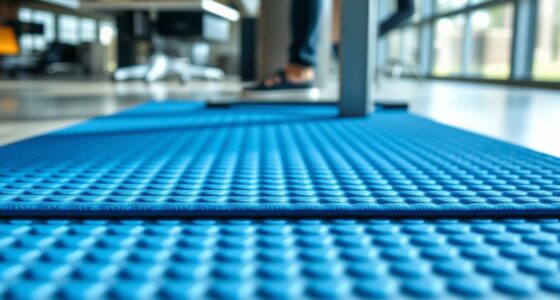Anti-fatigue mats are scientifically designed to decrease muscle fatigue and improve posture when you stand for long periods. They reduce stress on your legs and back by promoting subtle muscle movements that boost circulation. This support helps prevent aches, injuries, and chronic discomfort, making your workspace safer and more comfortable. If you want to understand how these mats work to benefit your health and productivity, keep exploring to find out more.
Key Takeaways
- Anti-fatigue mats stimulate subtle muscle movements, enhancing blood flow and reducing fatigue during prolonged standing.
- They absorb shock and impact, decreasing joint and muscle stress for better endurance.
- The cushioned surfaces promote proper posture, supporting musculoskeletal health and preventing chronic pain.
- Made from durable, slip-resistant materials, they ensure safety and long-term support in demanding work environments.
- Using anti-fatigue mats improves comfort and productivity, contributing to overall well-being and workspace safety.

Are you tired of discomfort and fatigue after long hours on your feet? If so, anti-fatigue mats can make a significant difference. These mats are designed to reduce stress on your legs and back, providing ergonomic benefits that improve your overall comfort. When you stand on a hard surface for extended periods, your muscles have to work harder to maintain stability, leading to fatigue and even pain. An anti-fatigue mat acts as a cushion, encouraging subtle muscle movements that promote better circulation and lessen strain. This ergonomic support helps you stay focused and productive, whether you’re working in a retail store, a workshop, or a kitchen.
Anti-fatigue mats reduce stress, improve circulation, and boost comfort during long hours on your feet.
One of the key reasons anti-fatigue mats are so effective lies in their material durability. High-quality mats are constructed from robust materials like rubber, foam, or gel composites that withstand daily wear and tear. Their durability ensures they maintain their supportive properties over time, so you don’t have to worry about replacing them frequently. Lightweight yet sturdy, these mats can endure the constant pressure of foot traffic without cracking or deteriorating, maintaining their ergonomic benefits for years. This longevity makes investing in a durable anti-fatigue mat a smart choice, especially if you spend many hours standing.
The material used in these mats also contributes to their comfort. Many feature a non-slip surface, preventing accidents and enhancing stability, which is vital for safety. The plush surface absorbs shock and reduces impact, easing the burden on your joints and muscles. Additionally, materials like closed-cell foam or rubber are excellent at resisting liquids and spills, making cleaning simple and preventing mold or bacteria buildup. This combination of material durability and comfort ensures your workspace remains both safe and inviting.
Furthermore, the ergonomic benefits extend beyond comfort. By reducing muscle fatigue, anti-fatigue mats can improve your posture and reduce the likelihood of developing chronic pain or musculoskeletal disorders. When your muscles aren’t constantly strained, you naturally adopt better standing habits, decreasing pressure on your lower back and legs. Incorporating anti-fatigue mats with high-quality materials is an effective way to enhance both safety and comfort in your workspace. Over time, this can lead to increased productivity and a better quality of life, especially if your job requires long hours standing.
Frequently Asked Questions
Are Anti-Fatigue Mats Suitable for Outdoor Use?
Anti-fatigue mats can be suitable for outdoor use if they feature weather resistance and pass durability testing. Look for mats made from materials like rubber or heavy-duty vinyl, which withstand moisture, UV rays, and temperature changes. Always check product specifications to confirm they’re designed for outdoor conditions. Properly selected outdoor mats help reduce fatigue and improve safety, making them a worthwhile investment for your outdoor workspaces.
How Do Anti-Fatigue Mats Impact Long-Term Health?
Using anti-fatigue mats can positively impact your long-term health by improving circulatory health and providing musculoskeletal benefits. When you stand on these mats, they reduce pressure on your joints and muscles, encouraging better blood flow. Over time, this helps prevent fatigue-related issues, decreases discomfort, and promotes overall well-being. Incorporating anti-fatigue mats into your daily routine supports a healthier posture and reduces the risk of chronic musculoskeletal problems.
Can Anti-Fatigue Mats Help Reduce Workplace Injuries?
Anti-fatigue mats can considerably help reduce workplace injuries by providing ergonomic benefits, such as better support and cushioning for your feet and legs. This reduces strain and fatigue, which can lead to missteps or accidents. By promoting proper posture and comfort, these mats enhance injury prevention, especially in jobs requiring long periods of standing. Investing in anti-fatigue mats creates a safer, healthier environment and minimizes your risk of injury.
What Materials Are Most Effective for Anti-Fatigue Mats?
You might wonder what materials are best for anti-fatigue mats. Foam cushioning is popular because it absorbs shock and reduces strain, making standing more comfortable. Rubber durability ensures the mat lasts longer under heavy use and resists wear and tear. While some believe softer materials are always better, studies show combining foam cushioning with rubber backing offers the ideal balance of comfort and longevity, proving the effectiveness of these materials together.
How Often Should Anti-Fatigue Mats Be Replaced?
You should replace your anti-fatigue mats when wear and tear become evident, typically every 1 to 3 years depending on usage. Regular inspections help determine if the mat’s surface has become cracked, flattened, or loses its cushioning, which can reduce effectiveness. Following a consistent replacement schedule ensures you maintain maximum comfort and safety, preventing potential slips or fatigue caused by degraded mats.
Conclusion
Now that you understand the science behind anti-fatigue mats, imagine what they could do for your daily comfort and productivity. Are you ready to experience less fatigue and more focus during those long hours on your feet? The secret isn’t just in the mat itself, but in how it transforms your work experience. Don’t wait — the difference could be just beneath your feet, waiting to change your routine forever.








